Unit 502 Report: Education and Training Theories, Principles, Models
VerifiedAdded on 2023/06/08
|25
|7890
|365
Report
AI Summary
This report, addressing Unit 502: Theories, Principles and Models in Education and Training, provides a comprehensive analysis of various learning theories, communication models, assessment principles, and curriculum development frameworks. It delves into the application of these concepts in teaching, learning, and assessment, focusing on how to identify and accommodate diverse learning preferences. The report also examines models of communication and their relevance to teaching, knowledge transfer, and assessment strategies. Furthermore, it explores theories of reflection and evaluation, emphasizing their importance in reviewing and improving educational practices. The report uses several learning theories like procedural vs declarative knowledge, scaffolding learning, and the VARK model. It examines how to apply these models to create inclusive teaching environments and develop effective curriculum design within specialized fields like marketing. The goal is to provide a holistic understanding of how to enhance educational practices through the strategic application of these theories and models.
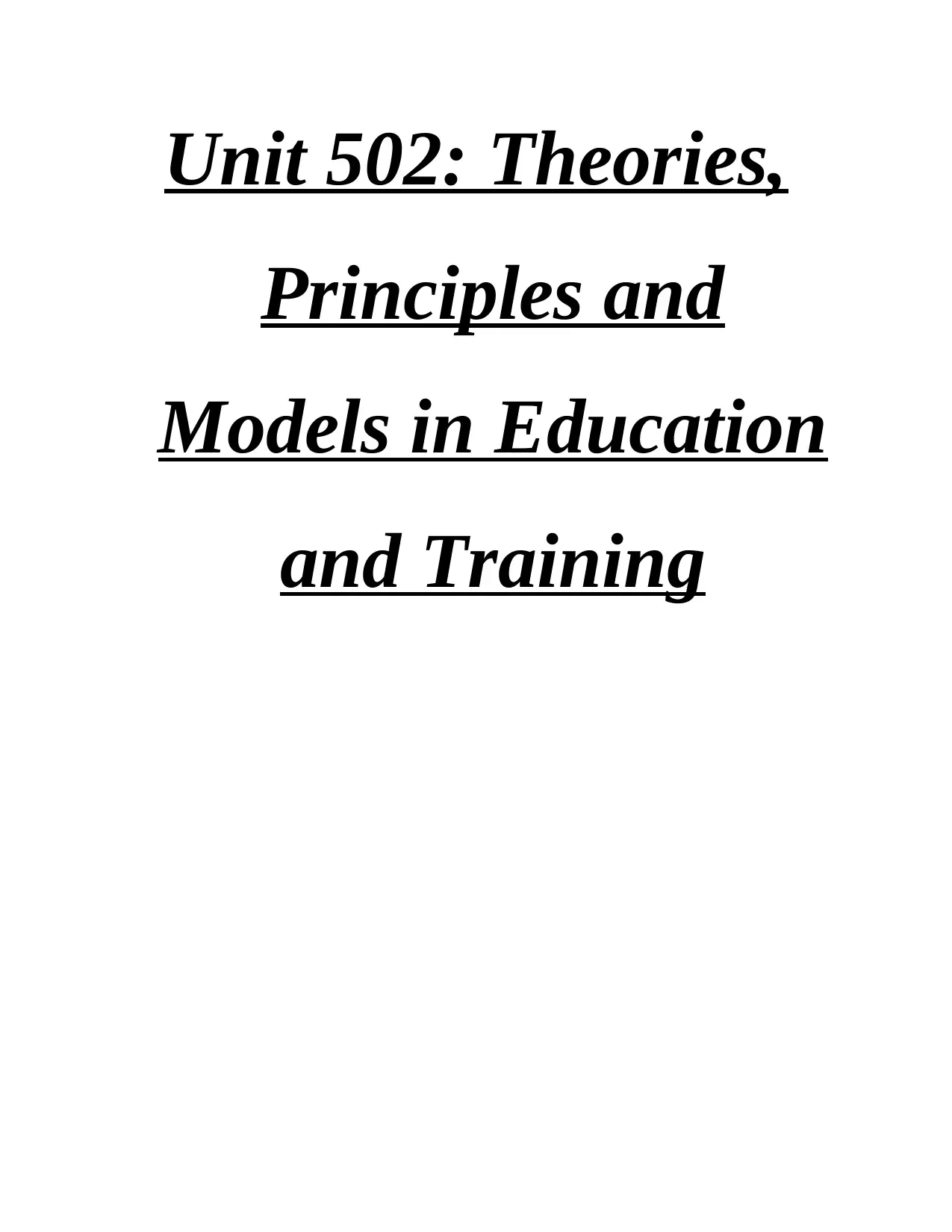
Unit 502: Theories,
Principles and
Models in Education
and Training
Principles and
Models in Education
and Training
Paraphrase This Document
Need a fresh take? Get an instant paraphrase of this document with our AI Paraphraser

Contents
INTRODUCTION...........................................................................................................................3
MAIN BODY...................................................................................................................................4
Task 1...............................................................................................................................................4
1.1 Analyse theories, principles and models of learning........................................................4
1.2 Explain ways in which theories, principles and models of learning can be applied to....5
teaching, learning and assessment..........................................................................................5
1.3 Analyse models of learning preferences...........................................................................6
1.4 Explain how identifying and taking account of learners’ individual learning preferences7
enables inclusive teaching, learning and assessment.............................................................7
Task 2...............................................................................................................................................8
2.1 Analyse theories, principles and models of communication............................................8
2.2. Purpose of communication principles and theories to assessment, knowledge and........9
teaching...................................................................................................................................9
Task 3.............................................................................................................................................11
3.1 Analyse theories, principles and models of assessment.................................................11
3.2 Explain ways in which theories, principles and models of assessment can be applied in12
assessing learning.................................................................................................................12
Task 4.............................................................................................................................................13
4.1 Analyse theories and models of curriculum and development.......................................13
4.2 Explain ways in which theories and models of curriculum development can be applied15
in developing curriculum in own area of specialism............................................................15
Task 5.............................................................................................................................................17
5.1 Analyse theories and models of reflection and evaluation.............................................17
5.2 Explain ways in which theories and models of reflection and evaluation can be applied19
to reviewing own practice....................................................................................................19
CONCLUSION..............................................................................................................................20
References......................................................................................................................................22
INTRODUCTION...........................................................................................................................3
MAIN BODY...................................................................................................................................4
Task 1...............................................................................................................................................4
1.1 Analyse theories, principles and models of learning........................................................4
1.2 Explain ways in which theories, principles and models of learning can be applied to....5
teaching, learning and assessment..........................................................................................5
1.3 Analyse models of learning preferences...........................................................................6
1.4 Explain how identifying and taking account of learners’ individual learning preferences7
enables inclusive teaching, learning and assessment.............................................................7
Task 2...............................................................................................................................................8
2.1 Analyse theories, principles and models of communication............................................8
2.2. Purpose of communication principles and theories to assessment, knowledge and........9
teaching...................................................................................................................................9
Task 3.............................................................................................................................................11
3.1 Analyse theories, principles and models of assessment.................................................11
3.2 Explain ways in which theories, principles and models of assessment can be applied in12
assessing learning.................................................................................................................12
Task 4.............................................................................................................................................13
4.1 Analyse theories and models of curriculum and development.......................................13
4.2 Explain ways in which theories and models of curriculum development can be applied15
in developing curriculum in own area of specialism............................................................15
Task 5.............................................................................................................................................17
5.1 Analyse theories and models of reflection and evaluation.............................................17
5.2 Explain ways in which theories and models of reflection and evaluation can be applied19
to reviewing own practice....................................................................................................19
CONCLUSION..............................................................................................................................20
References......................................................................................................................................22
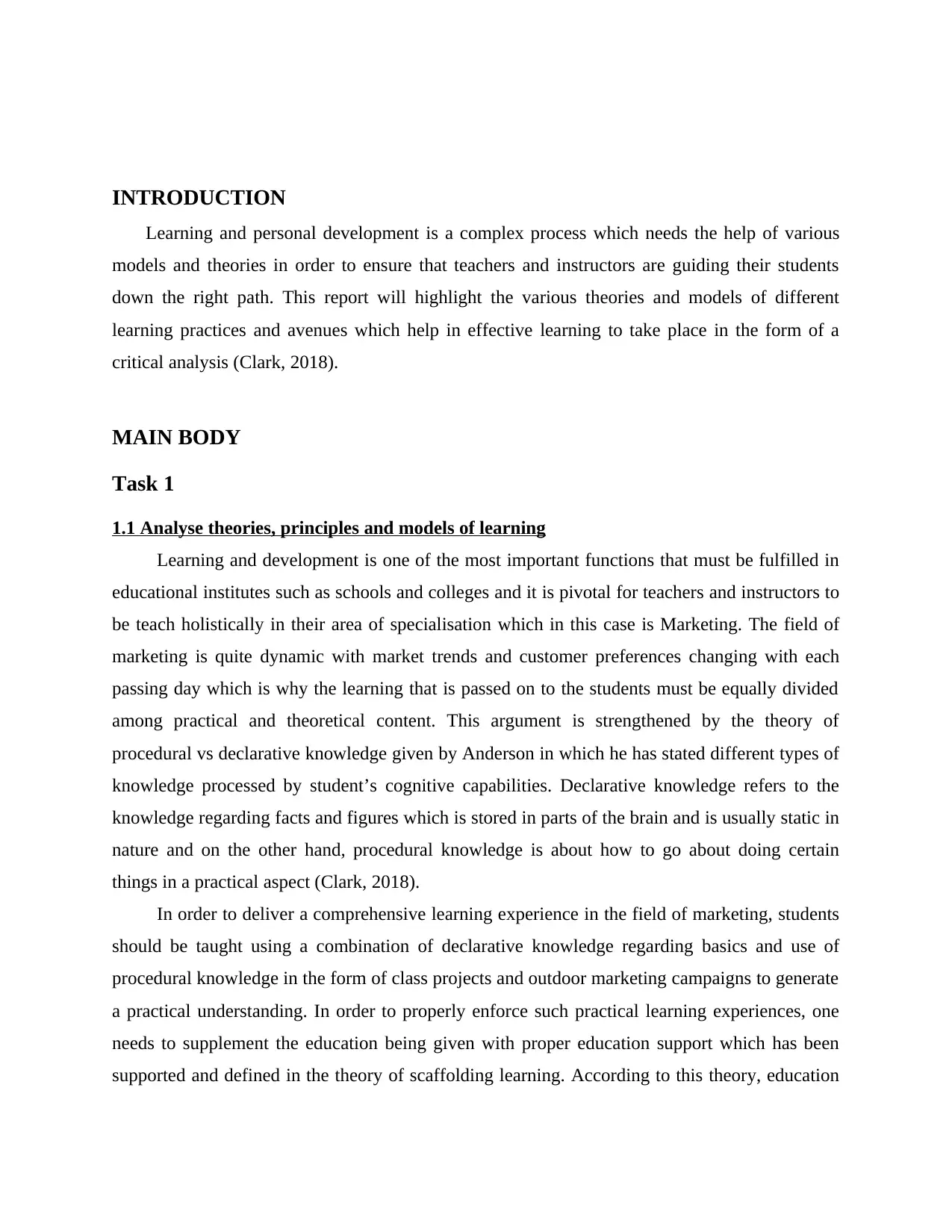
INTRODUCTION
Learning and personal development is a complex process which needs the help of various
models and theories in order to ensure that teachers and instructors are guiding their students
down the right path. This report will highlight the various theories and models of different
learning practices and avenues which help in effective learning to take place in the form of a
critical analysis (Clark, 2018).
MAIN BODY
Task 1
1.1 Analyse theories, principles and models of learning
Learning and development is one of the most important functions that must be fulfilled in
educational institutes such as schools and colleges and it is pivotal for teachers and instructors to
be teach holistically in their area of specialisation which in this case is Marketing. The field of
marketing is quite dynamic with market trends and customer preferences changing with each
passing day which is why the learning that is passed on to the students must be equally divided
among practical and theoretical content. This argument is strengthened by the theory of
procedural vs declarative knowledge given by Anderson in which he has stated different types of
knowledge processed by student’s cognitive capabilities. Declarative knowledge refers to the
knowledge regarding facts and figures which is stored in parts of the brain and is usually static in
nature and on the other hand, procedural knowledge is about how to go about doing certain
things in a practical aspect (Clark, 2018).
In order to deliver a comprehensive learning experience in the field of marketing, students
should be taught using a combination of declarative knowledge regarding basics and use of
procedural knowledge in the form of class projects and outdoor marketing campaigns to generate
a practical understanding. In order to properly enforce such practical learning experiences, one
needs to supplement the education being given with proper education support which has been
supported and defined in the theory of scaffolding learning. According to this theory, education
Learning and personal development is a complex process which needs the help of various
models and theories in order to ensure that teachers and instructors are guiding their students
down the right path. This report will highlight the various theories and models of different
learning practices and avenues which help in effective learning to take place in the form of a
critical analysis (Clark, 2018).
MAIN BODY
Task 1
1.1 Analyse theories, principles and models of learning
Learning and development is one of the most important functions that must be fulfilled in
educational institutes such as schools and colleges and it is pivotal for teachers and instructors to
be teach holistically in their area of specialisation which in this case is Marketing. The field of
marketing is quite dynamic with market trends and customer preferences changing with each
passing day which is why the learning that is passed on to the students must be equally divided
among practical and theoretical content. This argument is strengthened by the theory of
procedural vs declarative knowledge given by Anderson in which he has stated different types of
knowledge processed by student’s cognitive capabilities. Declarative knowledge refers to the
knowledge regarding facts and figures which is stored in parts of the brain and is usually static in
nature and on the other hand, procedural knowledge is about how to go about doing certain
things in a practical aspect (Clark, 2018).
In order to deliver a comprehensive learning experience in the field of marketing, students
should be taught using a combination of declarative knowledge regarding basics and use of
procedural knowledge in the form of class projects and outdoor marketing campaigns to generate
a practical understanding. In order to properly enforce such practical learning experiences, one
needs to supplement the education being given with proper education support which has been
supported and defined in the theory of scaffolding learning. According to this theory, education
⊘ This is a preview!⊘
Do you want full access?
Subscribe today to unlock all pages.

Trusted by 1+ million students worldwide
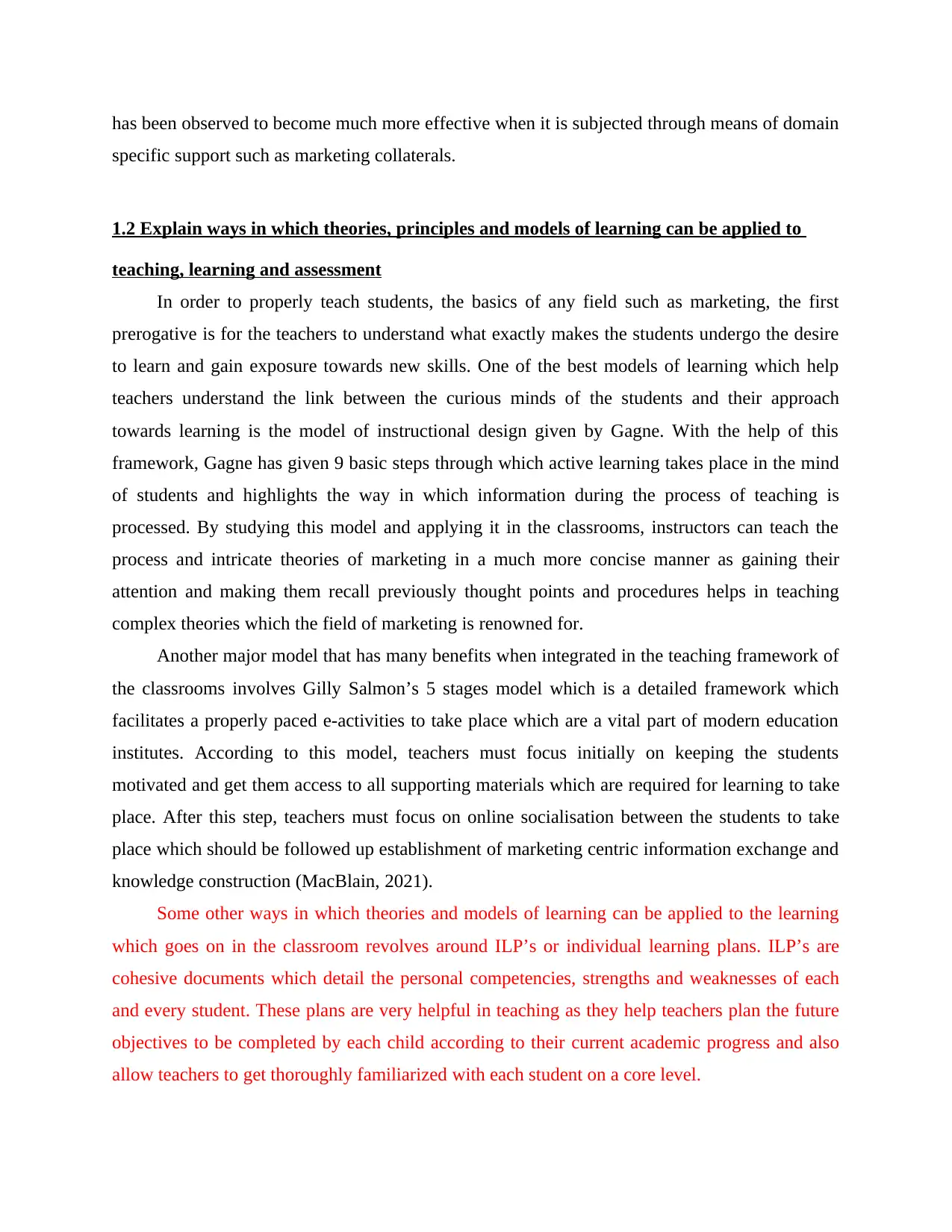
has been observed to become much more effective when it is subjected through means of domain
specific support such as marketing collaterals.
1.2 Explain ways in which theories, principles and models of learning can be applied to
teaching, learning and assessment
In order to properly teach students, the basics of any field such as marketing, the first
prerogative is for the teachers to understand what exactly makes the students undergo the desire
to learn and gain exposure towards new skills. One of the best models of learning which help
teachers understand the link between the curious minds of the students and their approach
towards learning is the model of instructional design given by Gagne. With the help of this
framework, Gagne has given 9 basic steps through which active learning takes place in the mind
of students and highlights the way in which information during the process of teaching is
processed. By studying this model and applying it in the classrooms, instructors can teach the
process and intricate theories of marketing in a much more concise manner as gaining their
attention and making them recall previously thought points and procedures helps in teaching
complex theories which the field of marketing is renowned for.
Another major model that has many benefits when integrated in the teaching framework of
the classrooms involves Gilly Salmon’s 5 stages model which is a detailed framework which
facilitates a properly paced e-activities to take place which are a vital part of modern education
institutes. According to this model, teachers must focus initially on keeping the students
motivated and get them access to all supporting materials which are required for learning to take
place. After this step, teachers must focus on online socialisation between the students to take
place which should be followed up establishment of marketing centric information exchange and
knowledge construction (MacBlain, 2021).
Some other ways in which theories and models of learning can be applied to the learning
which goes on in the classroom revolves around ILP’s or individual learning plans. ILP’s are
cohesive documents which detail the personal competencies, strengths and weaknesses of each
and every student. These plans are very helpful in teaching as they help teachers plan the future
objectives to be completed by each child according to their current academic progress and also
allow teachers to get thoroughly familiarized with each student on a core level.
specific support such as marketing collaterals.
1.2 Explain ways in which theories, principles and models of learning can be applied to
teaching, learning and assessment
In order to properly teach students, the basics of any field such as marketing, the first
prerogative is for the teachers to understand what exactly makes the students undergo the desire
to learn and gain exposure towards new skills. One of the best models of learning which help
teachers understand the link between the curious minds of the students and their approach
towards learning is the model of instructional design given by Gagne. With the help of this
framework, Gagne has given 9 basic steps through which active learning takes place in the mind
of students and highlights the way in which information during the process of teaching is
processed. By studying this model and applying it in the classrooms, instructors can teach the
process and intricate theories of marketing in a much more concise manner as gaining their
attention and making them recall previously thought points and procedures helps in teaching
complex theories which the field of marketing is renowned for.
Another major model that has many benefits when integrated in the teaching framework of
the classrooms involves Gilly Salmon’s 5 stages model which is a detailed framework which
facilitates a properly paced e-activities to take place which are a vital part of modern education
institutes. According to this model, teachers must focus initially on keeping the students
motivated and get them access to all supporting materials which are required for learning to take
place. After this step, teachers must focus on online socialisation between the students to take
place which should be followed up establishment of marketing centric information exchange and
knowledge construction (MacBlain, 2021).
Some other ways in which theories and models of learning can be applied to the learning
which goes on in the classroom revolves around ILP’s or individual learning plans. ILP’s are
cohesive documents which detail the personal competencies, strengths and weaknesses of each
and every student. These plans are very helpful in teaching as they help teachers plan the future
objectives to be completed by each child according to their current academic progress and also
allow teachers to get thoroughly familiarized with each student on a core level.
Paraphrase This Document
Need a fresh take? Get an instant paraphrase of this document with our AI Paraphraser
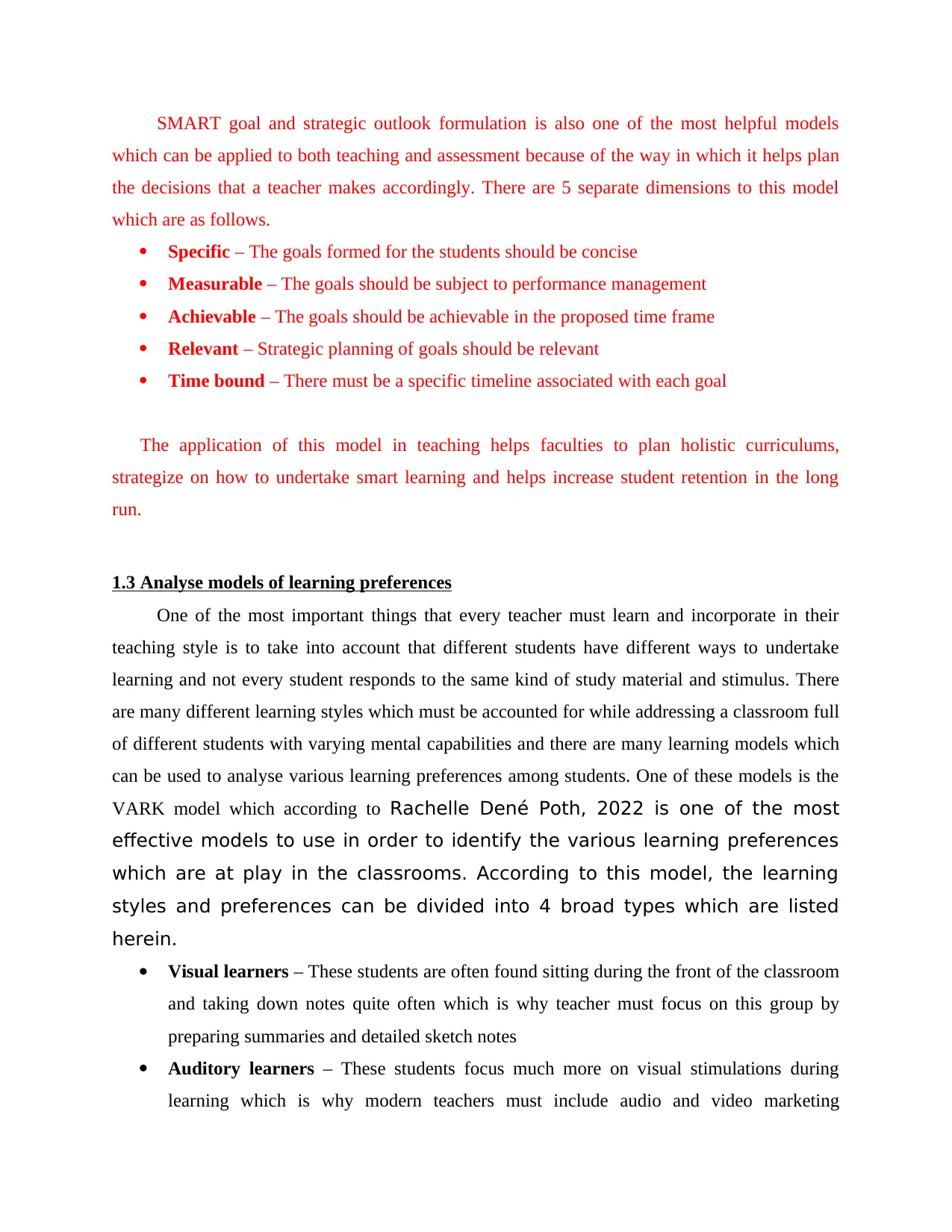
SMART goal and strategic outlook formulation is also one of the most helpful models
which can be applied to both teaching and assessment because of the way in which it helps plan
the decisions that a teacher makes accordingly. There are 5 separate dimensions to this model
which are as follows.
Specific – The goals formed for the students should be concise
Measurable – The goals should be subject to performance management
Achievable – The goals should be achievable in the proposed time frame
Relevant – Strategic planning of goals should be relevant
Time bound – There must be a specific timeline associated with each goal
The application of this model in teaching helps faculties to plan holistic curriculums,
strategize on how to undertake smart learning and helps increase student retention in the long
run.
1.3 Analyse models of learning preferences
One of the most important things that every teacher must learn and incorporate in their
teaching style is to take into account that different students have different ways to undertake
learning and not every student responds to the same kind of study material and stimulus. There
are many different learning styles which must be accounted for while addressing a classroom full
of different students with varying mental capabilities and there are many learning models which
can be used to analyse various learning preferences among students. One of these models is the
VARK model which according to Rachelle Dené Poth, 2022 is one of the most
effective models to use in order to identify the various learning preferences
which are at play in the classrooms. According to this model, the learning
styles and preferences can be divided into 4 broad types which are listed
herein.
Visual learners – These students are often found sitting during the front of the classroom
and taking down notes quite often which is why teacher must focus on this group by
preparing summaries and detailed sketch notes
Auditory learners – These students focus much more on visual stimulations during
learning which is why modern teachers must include audio and video marketing
which can be applied to both teaching and assessment because of the way in which it helps plan
the decisions that a teacher makes accordingly. There are 5 separate dimensions to this model
which are as follows.
Specific – The goals formed for the students should be concise
Measurable – The goals should be subject to performance management
Achievable – The goals should be achievable in the proposed time frame
Relevant – Strategic planning of goals should be relevant
Time bound – There must be a specific timeline associated with each goal
The application of this model in teaching helps faculties to plan holistic curriculums,
strategize on how to undertake smart learning and helps increase student retention in the long
run.
1.3 Analyse models of learning preferences
One of the most important things that every teacher must learn and incorporate in their
teaching style is to take into account that different students have different ways to undertake
learning and not every student responds to the same kind of study material and stimulus. There
are many different learning styles which must be accounted for while addressing a classroom full
of different students with varying mental capabilities and there are many learning models which
can be used to analyse various learning preferences among students. One of these models is the
VARK model which according to Rachelle Dené Poth, 2022 is one of the most
effective models to use in order to identify the various learning preferences
which are at play in the classrooms. According to this model, the learning
styles and preferences can be divided into 4 broad types which are listed
herein.
Visual learners – These students are often found sitting during the front of the classroom
and taking down notes quite often which is why teacher must focus on this group by
preparing summaries and detailed sketch notes
Auditory learners – These students focus much more on visual stimulations during
learning which is why modern teachers must include audio and video marketing
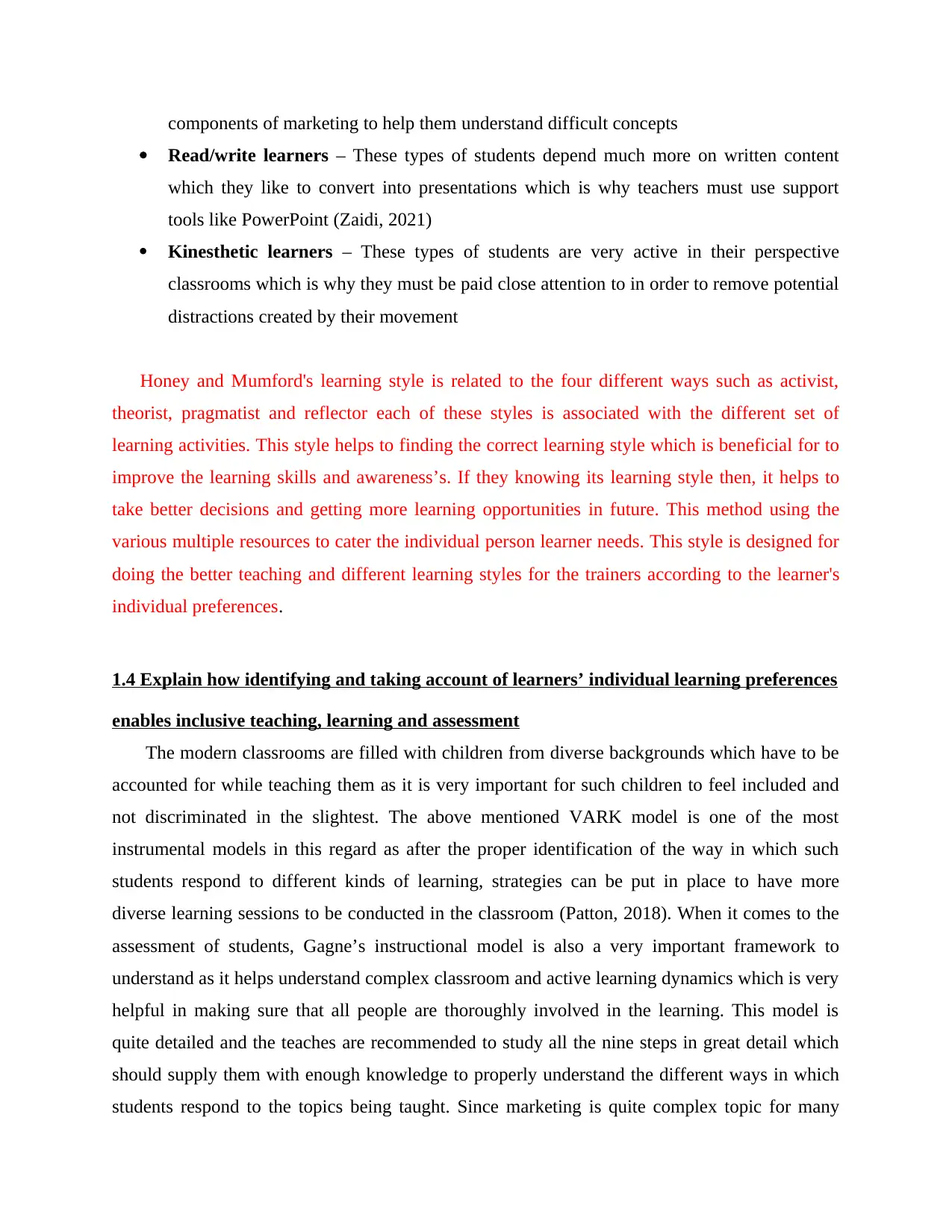
components of marketing to help them understand difficult concepts
Read/write learners – These types of students depend much more on written content
which they like to convert into presentations which is why teachers must use support
tools like PowerPoint (Zaidi, 2021)
Kinesthetic learners – These types of students are very active in their perspective
classrooms which is why they must be paid close attention to in order to remove potential
distractions created by their movement
Honey and Mumford's learning style is related to the four different ways such as activist,
theorist, pragmatist and reflector each of these styles is associated with the different set of
learning activities. This style helps to finding the correct learning style which is beneficial for to
improve the learning skills and awareness’s. If they knowing its learning style then, it helps to
take better decisions and getting more learning opportunities in future. This method using the
various multiple resources to cater the individual person learner needs. This style is designed for
doing the better teaching and different learning styles for the trainers according to the learner's
individual preferences.
1.4 Explain how identifying and taking account of learners’ individual learning preferences
enables inclusive teaching, learning and assessment
The modern classrooms are filled with children from diverse backgrounds which have to be
accounted for while teaching them as it is very important for such children to feel included and
not discriminated in the slightest. The above mentioned VARK model is one of the most
instrumental models in this regard as after the proper identification of the way in which such
students respond to different kinds of learning, strategies can be put in place to have more
diverse learning sessions to be conducted in the classroom (Patton, 2018). When it comes to the
assessment of students, Gagne’s instructional model is also a very important framework to
understand as it helps understand complex classroom and active learning dynamics which is very
helpful in making sure that all people are thoroughly involved in the learning. This model is
quite detailed and the teaches are recommended to study all the nine steps in great detail which
should supply them with enough knowledge to properly understand the different ways in which
students respond to the topics being taught. Since marketing is quite complex topic for many
Read/write learners – These types of students depend much more on written content
which they like to convert into presentations which is why teachers must use support
tools like PowerPoint (Zaidi, 2021)
Kinesthetic learners – These types of students are very active in their perspective
classrooms which is why they must be paid close attention to in order to remove potential
distractions created by their movement
Honey and Mumford's learning style is related to the four different ways such as activist,
theorist, pragmatist and reflector each of these styles is associated with the different set of
learning activities. This style helps to finding the correct learning style which is beneficial for to
improve the learning skills and awareness’s. If they knowing its learning style then, it helps to
take better decisions and getting more learning opportunities in future. This method using the
various multiple resources to cater the individual person learner needs. This style is designed for
doing the better teaching and different learning styles for the trainers according to the learner's
individual preferences.
1.4 Explain how identifying and taking account of learners’ individual learning preferences
enables inclusive teaching, learning and assessment
The modern classrooms are filled with children from diverse backgrounds which have to be
accounted for while teaching them as it is very important for such children to feel included and
not discriminated in the slightest. The above mentioned VARK model is one of the most
instrumental models in this regard as after the proper identification of the way in which such
students respond to different kinds of learning, strategies can be put in place to have more
diverse learning sessions to be conducted in the classroom (Patton, 2018). When it comes to the
assessment of students, Gagne’s instructional model is also a very important framework to
understand as it helps understand complex classroom and active learning dynamics which is very
helpful in making sure that all people are thoroughly involved in the learning. This model is
quite detailed and the teaches are recommended to study all the nine steps in great detail which
should supply them with enough knowledge to properly understand the different ways in which
students respond to the topics being taught. Since marketing is quite complex topic for many
⊘ This is a preview!⊘
Do you want full access?
Subscribe today to unlock all pages.

Trusted by 1+ million students worldwide
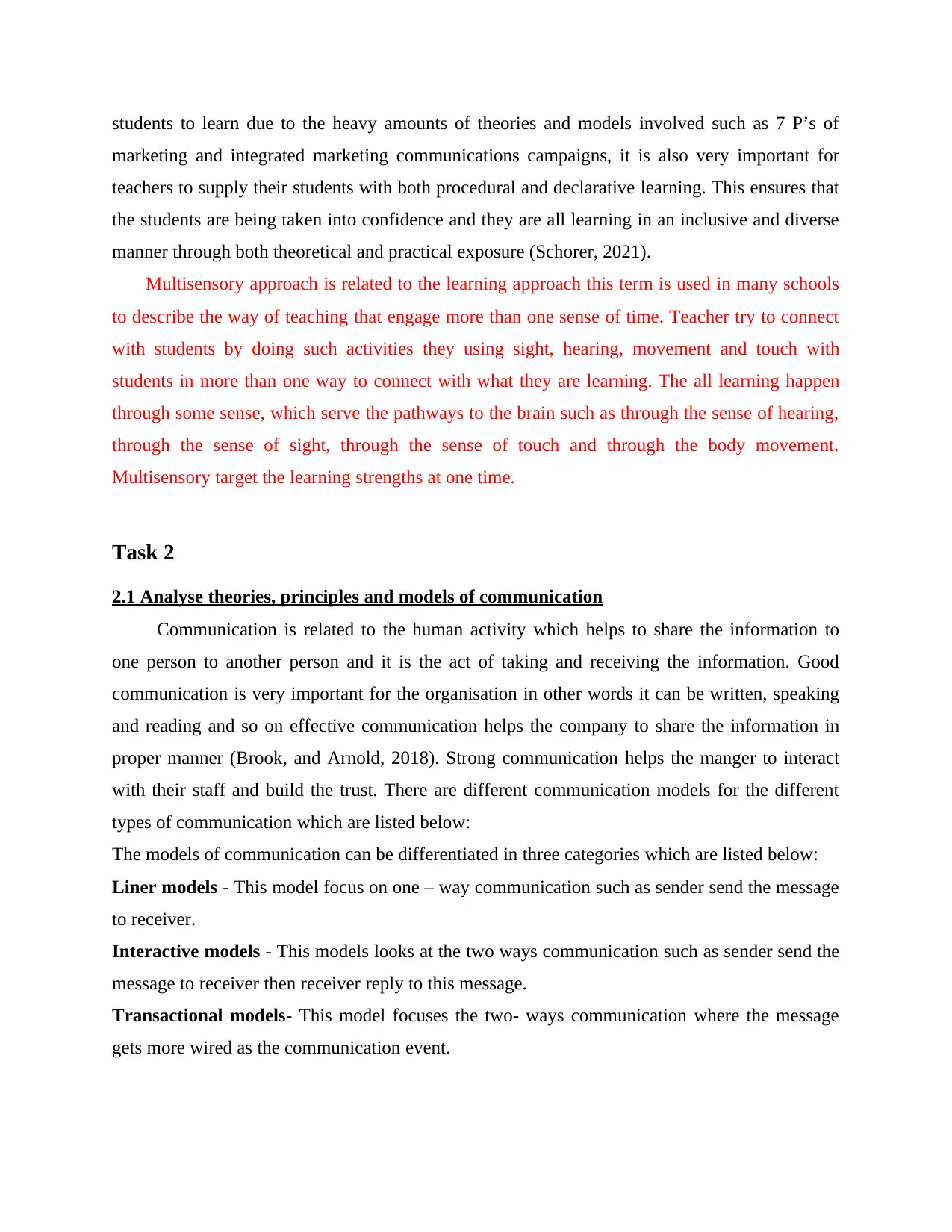
students to learn due to the heavy amounts of theories and models involved such as 7 P’s of
marketing and integrated marketing communications campaigns, it is also very important for
teachers to supply their students with both procedural and declarative learning. This ensures that
the students are being taken into confidence and they are all learning in an inclusive and diverse
manner through both theoretical and practical exposure (Schorer, 2021).
Multisensory approach is related to the learning approach this term is used in many schools
to describe the way of teaching that engage more than one sense of time. Teacher try to connect
with students by doing such activities they using sight, hearing, movement and touch with
students in more than one way to connect with what they are learning. The all learning happen
through some sense, which serve the pathways to the brain such as through the sense of hearing,
through the sense of sight, through the sense of touch and through the body movement.
Multisensory target the learning strengths at one time.
Task 2
2.1 Analyse theories, principles and models of communication
Communication is related to the human activity which helps to share the information to
one person to another person and it is the act of taking and receiving the information. Good
communication is very important for the organisation in other words it can be written, speaking
and reading and so on effective communication helps the company to share the information in
proper manner (Brook, and Arnold, 2018). Strong communication helps the manger to interact
with their staff and build the trust. There are different communication models for the different
types of communication which are listed below:
The models of communication can be differentiated in three categories which are listed below:
Liner models - This model focus on one – way communication such as sender send the message
to receiver.
Interactive models - This models looks at the two ways communication such as sender send the
message to receiver then receiver reply to this message.
Transactional models- This model focuses the two- ways communication where the message
gets more wired as the communication event.
marketing and integrated marketing communications campaigns, it is also very important for
teachers to supply their students with both procedural and declarative learning. This ensures that
the students are being taken into confidence and they are all learning in an inclusive and diverse
manner through both theoretical and practical exposure (Schorer, 2021).
Multisensory approach is related to the learning approach this term is used in many schools
to describe the way of teaching that engage more than one sense of time. Teacher try to connect
with students by doing such activities they using sight, hearing, movement and touch with
students in more than one way to connect with what they are learning. The all learning happen
through some sense, which serve the pathways to the brain such as through the sense of hearing,
through the sense of sight, through the sense of touch and through the body movement.
Multisensory target the learning strengths at one time.
Task 2
2.1 Analyse theories, principles and models of communication
Communication is related to the human activity which helps to share the information to
one person to another person and it is the act of taking and receiving the information. Good
communication is very important for the organisation in other words it can be written, speaking
and reading and so on effective communication helps the company to share the information in
proper manner (Brook, and Arnold, 2018). Strong communication helps the manger to interact
with their staff and build the trust. There are different communication models for the different
types of communication which are listed below:
The models of communication can be differentiated in three categories which are listed below:
Liner models - This model focus on one – way communication such as sender send the message
to receiver.
Interactive models - This models looks at the two ways communication such as sender send the
message to receiver then receiver reply to this message.
Transactional models- This model focuses the two- ways communication where the message
gets more wired as the communication event.
Paraphrase This Document
Need a fresh take? Get an instant paraphrase of this document with our AI Paraphraser
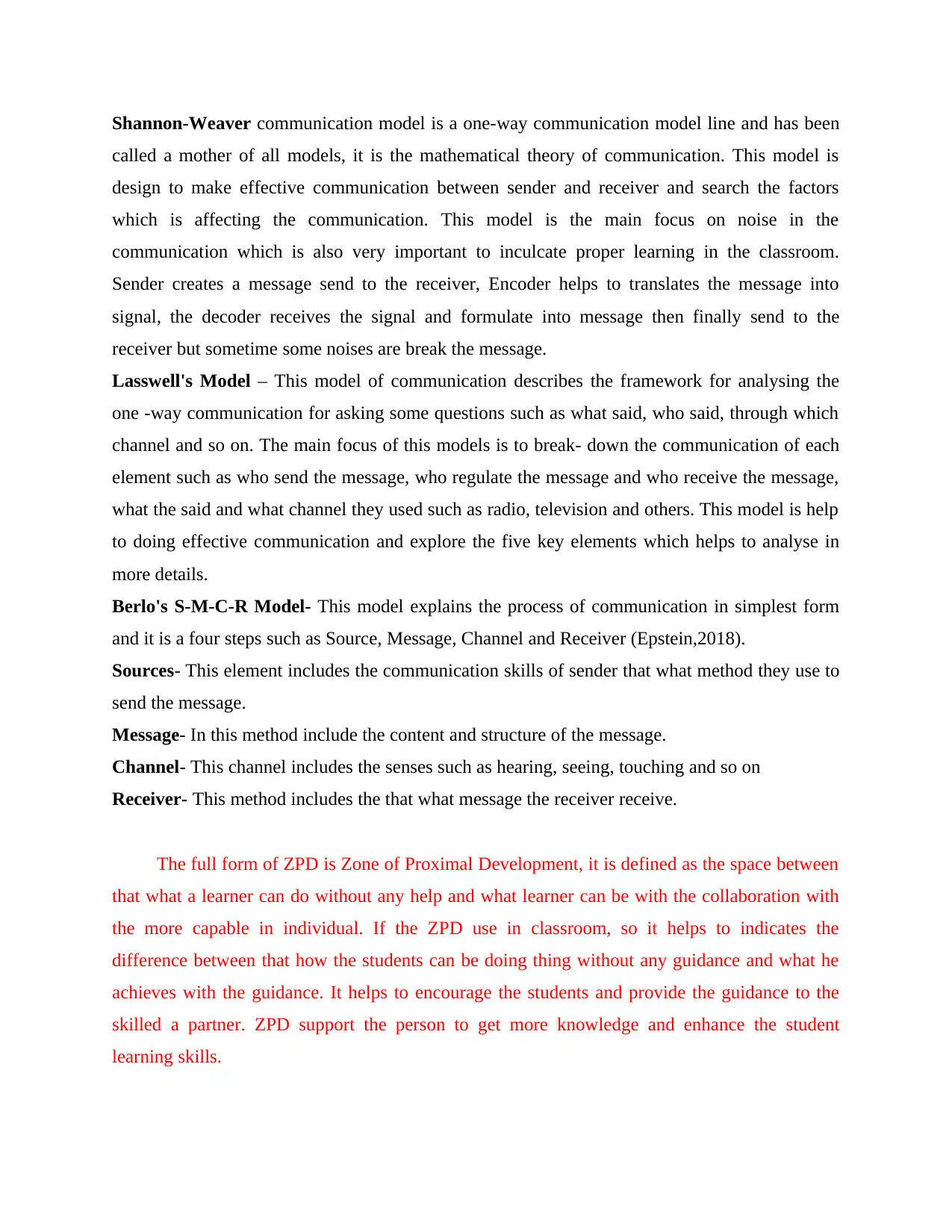
Shannon-Weaver communication model is a one-way communication model line and has been
called a mother of all models, it is the mathematical theory of communication. This model is
design to make effective communication between sender and receiver and search the factors
which is affecting the communication. This model is the main focus on noise in the
communication which is also very important to inculcate proper learning in the classroom.
Sender creates a message send to the receiver, Encoder helps to translates the message into
signal, the decoder receives the signal and formulate into message then finally send to the
receiver but sometime some noises are break the message.
Lasswell's Model – This model of communication describes the framework for analysing the
one -way communication for asking some questions such as what said, who said, through which
channel and so on. The main focus of this models is to break- down the communication of each
element such as who send the message, who regulate the message and who receive the message,
what the said and what channel they used such as radio, television and others. This model is help
to doing effective communication and explore the five key elements which helps to analyse in
more details.
Berlo's S-M-C-R Model- This model explains the process of communication in simplest form
and it is a four steps such as Source, Message, Channel and Receiver (Epstein,2018).
Sources- This element includes the communication skills of sender that what method they use to
send the message.
Message- In this method include the content and structure of the message.
Channel- This channel includes the senses such as hearing, seeing, touching and so on
Receiver- This method includes the that what message the receiver receive.
The full form of ZPD is Zone of Proximal Development, it is defined as the space between
that what a learner can do without any help and what learner can be with the collaboration with
the more capable in individual. If the ZPD use in classroom, so it helps to indicates the
difference between that how the students can be doing thing without any guidance and what he
achieves with the guidance. It helps to encourage the students and provide the guidance to the
skilled a partner. ZPD support the person to get more knowledge and enhance the student
learning skills.
called a mother of all models, it is the mathematical theory of communication. This model is
design to make effective communication between sender and receiver and search the factors
which is affecting the communication. This model is the main focus on noise in the
communication which is also very important to inculcate proper learning in the classroom.
Sender creates a message send to the receiver, Encoder helps to translates the message into
signal, the decoder receives the signal and formulate into message then finally send to the
receiver but sometime some noises are break the message.
Lasswell's Model – This model of communication describes the framework for analysing the
one -way communication for asking some questions such as what said, who said, through which
channel and so on. The main focus of this models is to break- down the communication of each
element such as who send the message, who regulate the message and who receive the message,
what the said and what channel they used such as radio, television and others. This model is help
to doing effective communication and explore the five key elements which helps to analyse in
more details.
Berlo's S-M-C-R Model- This model explains the process of communication in simplest form
and it is a four steps such as Source, Message, Channel and Receiver (Epstein,2018).
Sources- This element includes the communication skills of sender that what method they use to
send the message.
Message- In this method include the content and structure of the message.
Channel- This channel includes the senses such as hearing, seeing, touching and so on
Receiver- This method includes the that what message the receiver receive.
The full form of ZPD is Zone of Proximal Development, it is defined as the space between
that what a learner can do without any help and what learner can be with the collaboration with
the more capable in individual. If the ZPD use in classroom, so it helps to indicates the
difference between that how the students can be doing thing without any guidance and what he
achieves with the guidance. It helps to encourage the students and provide the guidance to the
skilled a partner. ZPD support the person to get more knowledge and enhance the student
learning skills.
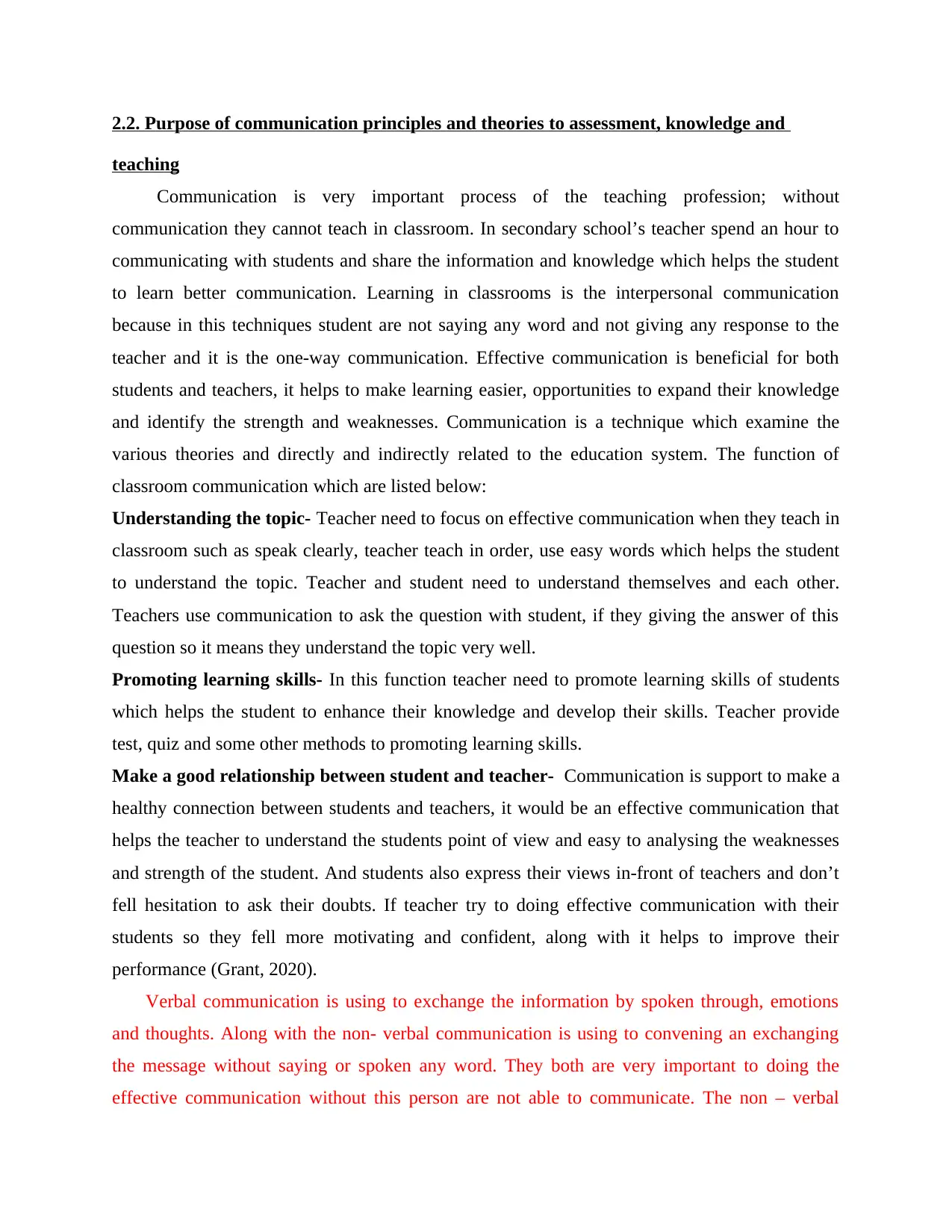
2.2. Purpose of communication principles and theories to assessment, knowledge and
teaching
Communication is very important process of the teaching profession; without
communication they cannot teach in classroom. In secondary school’s teacher spend an hour to
communicating with students and share the information and knowledge which helps the student
to learn better communication. Learning in classrooms is the interpersonal communication
because in this techniques student are not saying any word and not giving any response to the
teacher and it is the one-way communication. Effective communication is beneficial for both
students and teachers, it helps to make learning easier, opportunities to expand their knowledge
and identify the strength and weaknesses. Communication is a technique which examine the
various theories and directly and indirectly related to the education system. The function of
classroom communication which are listed below:
Understanding the topic- Teacher need to focus on effective communication when they teach in
classroom such as speak clearly, teacher teach in order, use easy words which helps the student
to understand the topic. Teacher and student need to understand themselves and each other.
Teachers use communication to ask the question with student, if they giving the answer of this
question so it means they understand the topic very well.
Promoting learning skills- In this function teacher need to promote learning skills of students
which helps the student to enhance their knowledge and develop their skills. Teacher provide
test, quiz and some other methods to promoting learning skills.
Make a good relationship between student and teacher- Communication is support to make a
healthy connection between students and teachers, it would be an effective communication that
helps the teacher to understand the students point of view and easy to analysing the weaknesses
and strength of the student. And students also express their views in-front of teachers and don’t
fell hesitation to ask their doubts. If teacher try to doing effective communication with their
students so they fell more motivating and confident, along with it helps to improve their
performance (Grant, 2020).
Verbal communication is using to exchange the information by spoken through, emotions
and thoughts. Along with the non- verbal communication is using to convening an exchanging
the message without saying or spoken any word. They both are very important to doing the
effective communication without this person are not able to communicate. The non – verbal
teaching
Communication is very important process of the teaching profession; without
communication they cannot teach in classroom. In secondary school’s teacher spend an hour to
communicating with students and share the information and knowledge which helps the student
to learn better communication. Learning in classrooms is the interpersonal communication
because in this techniques student are not saying any word and not giving any response to the
teacher and it is the one-way communication. Effective communication is beneficial for both
students and teachers, it helps to make learning easier, opportunities to expand their knowledge
and identify the strength and weaknesses. Communication is a technique which examine the
various theories and directly and indirectly related to the education system. The function of
classroom communication which are listed below:
Understanding the topic- Teacher need to focus on effective communication when they teach in
classroom such as speak clearly, teacher teach in order, use easy words which helps the student
to understand the topic. Teacher and student need to understand themselves and each other.
Teachers use communication to ask the question with student, if they giving the answer of this
question so it means they understand the topic very well.
Promoting learning skills- In this function teacher need to promote learning skills of students
which helps the student to enhance their knowledge and develop their skills. Teacher provide
test, quiz and some other methods to promoting learning skills.
Make a good relationship between student and teacher- Communication is support to make a
healthy connection between students and teachers, it would be an effective communication that
helps the teacher to understand the students point of view and easy to analysing the weaknesses
and strength of the student. And students also express their views in-front of teachers and don’t
fell hesitation to ask their doubts. If teacher try to doing effective communication with their
students so they fell more motivating and confident, along with it helps to improve their
performance (Grant, 2020).
Verbal communication is using to exchange the information by spoken through, emotions
and thoughts. Along with the non- verbal communication is using to convening an exchanging
the message without saying or spoken any word. They both are very important to doing the
effective communication without this person are not able to communicate. The non – verbal
⊘ This is a preview!⊘
Do you want full access?
Subscribe today to unlock all pages.

Trusted by 1+ million students worldwide
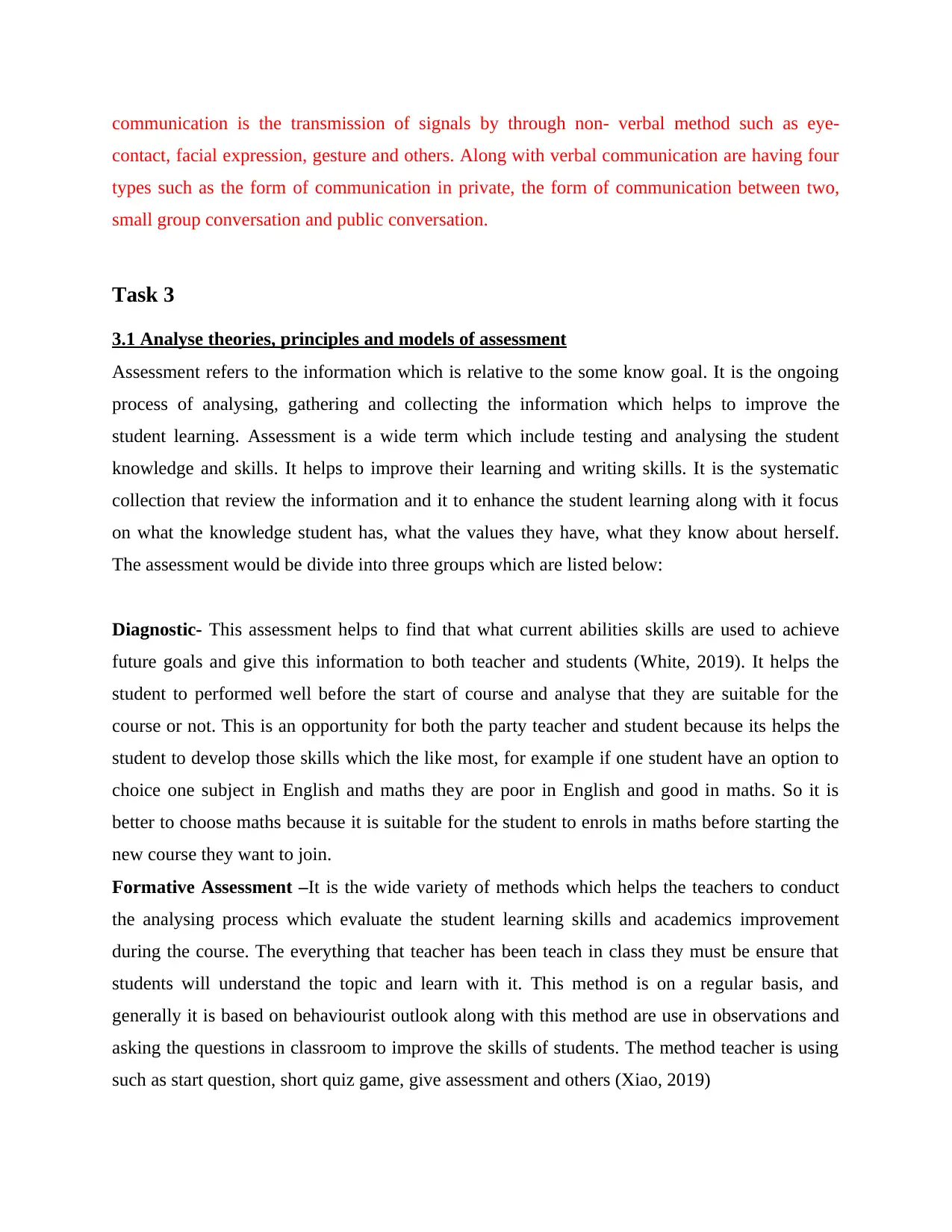
communication is the transmission of signals by through non- verbal method such as eye-
contact, facial expression, gesture and others. Along with verbal communication are having four
types such as the form of communication in private, the form of communication between two,
small group conversation and public conversation.
Task 3
3.1 Analyse theories, principles and models of assessment
Assessment refers to the information which is relative to the some know goal. It is the ongoing
process of analysing, gathering and collecting the information which helps to improve the
student learning. Assessment is a wide term which include testing and analysing the student
knowledge and skills. It helps to improve their learning and writing skills. It is the systematic
collection that review the information and it to enhance the student learning along with it focus
on what the knowledge student has, what the values they have, what they know about herself.
The assessment would be divide into three groups which are listed below:
Diagnostic- This assessment helps to find that what current abilities skills are used to achieve
future goals and give this information to both teacher and students (White, 2019). It helps the
student to performed well before the start of course and analyse that they are suitable for the
course or not. This is an opportunity for both the party teacher and student because its helps the
student to develop those skills which the like most, for example if one student have an option to
choice one subject in English and maths they are poor in English and good in maths. So it is
better to choose maths because it is suitable for the student to enrols in maths before starting the
new course they want to join.
Formative Assessment –It is the wide variety of methods which helps the teachers to conduct
the analysing process which evaluate the student learning skills and academics improvement
during the course. The everything that teacher has been teach in class they must be ensure that
students will understand the topic and learn with it. This method is on a regular basis, and
generally it is based on behaviourist outlook along with this method are use in observations and
asking the questions in classroom to improve the skills of students. The method teacher is using
such as start question, short quiz game, give assessment and others (Xiao, 2019)
contact, facial expression, gesture and others. Along with verbal communication are having four
types such as the form of communication in private, the form of communication between two,
small group conversation and public conversation.
Task 3
3.1 Analyse theories, principles and models of assessment
Assessment refers to the information which is relative to the some know goal. It is the ongoing
process of analysing, gathering and collecting the information which helps to improve the
student learning. Assessment is a wide term which include testing and analysing the student
knowledge and skills. It helps to improve their learning and writing skills. It is the systematic
collection that review the information and it to enhance the student learning along with it focus
on what the knowledge student has, what the values they have, what they know about herself.
The assessment would be divide into three groups which are listed below:
Diagnostic- This assessment helps to find that what current abilities skills are used to achieve
future goals and give this information to both teacher and students (White, 2019). It helps the
student to performed well before the start of course and analyse that they are suitable for the
course or not. This is an opportunity for both the party teacher and student because its helps the
student to develop those skills which the like most, for example if one student have an option to
choice one subject in English and maths they are poor in English and good in maths. So it is
better to choose maths because it is suitable for the student to enrols in maths before starting the
new course they want to join.
Formative Assessment –It is the wide variety of methods which helps the teachers to conduct
the analysing process which evaluate the student learning skills and academics improvement
during the course. The everything that teacher has been teach in class they must be ensure that
students will understand the topic and learn with it. This method is on a regular basis, and
generally it is based on behaviourist outlook along with this method are use in observations and
asking the questions in classroom to improve the skills of students. The method teacher is using
such as start question, short quiz game, give assessment and others (Xiao, 2019)
Paraphrase This Document
Need a fresh take? Get an instant paraphrase of this document with our AI Paraphraser
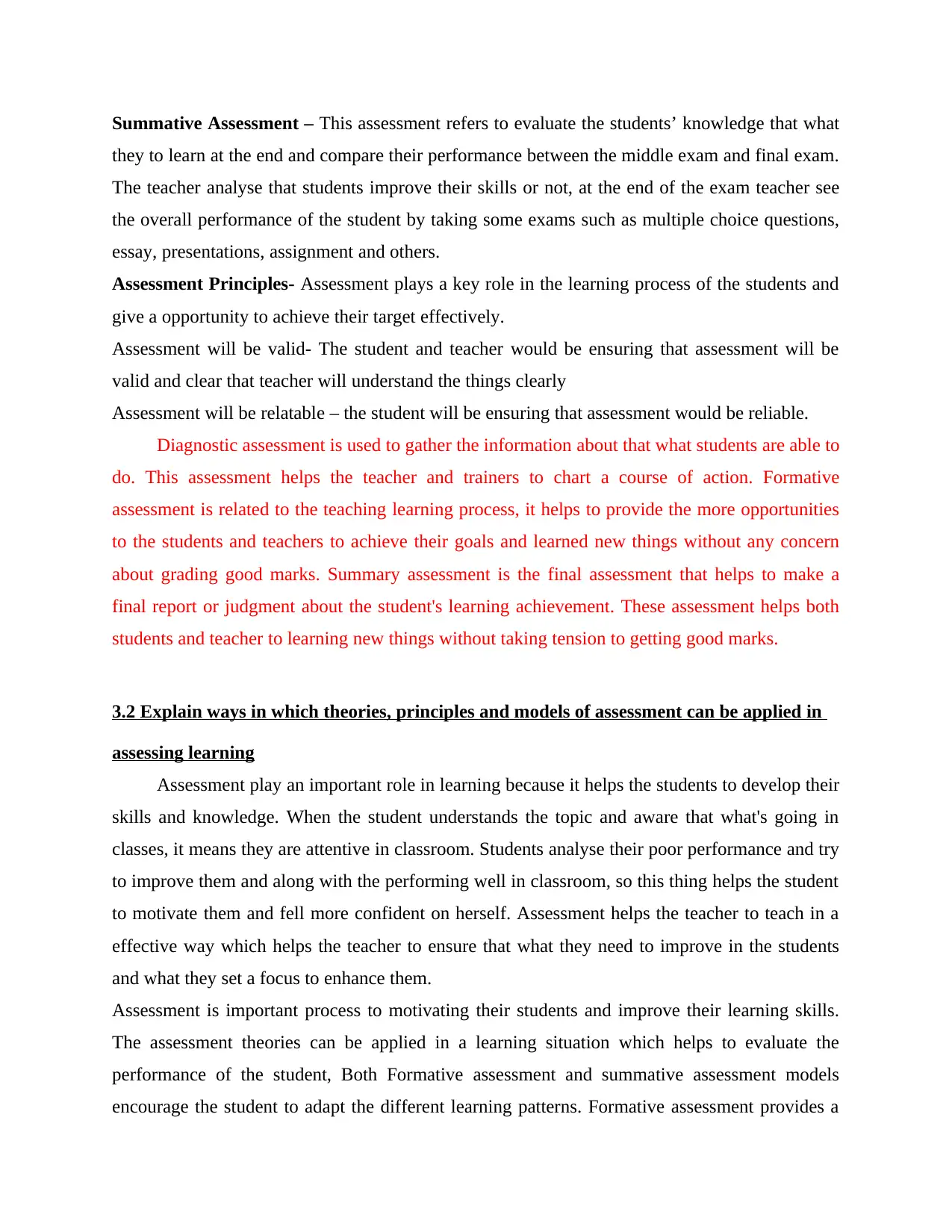
Summative Assessment – This assessment refers to evaluate the students’ knowledge that what
they to learn at the end and compare their performance between the middle exam and final exam.
The teacher analyse that students improve their skills or not, at the end of the exam teacher see
the overall performance of the student by taking some exams such as multiple choice questions,
essay, presentations, assignment and others.
Assessment Principles- Assessment plays a key role in the learning process of the students and
give a opportunity to achieve their target effectively.
Assessment will be valid- The student and teacher would be ensuring that assessment will be
valid and clear that teacher will understand the things clearly
Assessment will be relatable – the student will be ensuring that assessment would be reliable.
Diagnostic assessment is used to gather the information about that what students are able to
do. This assessment helps the teacher and trainers to chart a course of action. Formative
assessment is related to the teaching learning process, it helps to provide the more opportunities
to the students and teachers to achieve their goals and learned new things without any concern
about grading good marks. Summary assessment is the final assessment that helps to make a
final report or judgment about the student's learning achievement. These assessment helps both
students and teacher to learning new things without taking tension to getting good marks.
3.2 Explain ways in which theories, principles and models of assessment can be applied in
assessing learning
Assessment play an important role in learning because it helps the students to develop their
skills and knowledge. When the student understands the topic and aware that what's going in
classes, it means they are attentive in classroom. Students analyse their poor performance and try
to improve them and along with the performing well in classroom, so this thing helps the student
to motivate them and fell more confident on herself. Assessment helps the teacher to teach in a
effective way which helps the teacher to ensure that what they need to improve in the students
and what they set a focus to enhance them.
Assessment is important process to motivating their students and improve their learning skills.
The assessment theories can be applied in a learning situation which helps to evaluate the
performance of the student, Both Formative assessment and summative assessment models
encourage the student to adapt the different learning patterns. Formative assessment provides a
they to learn at the end and compare their performance between the middle exam and final exam.
The teacher analyse that students improve their skills or not, at the end of the exam teacher see
the overall performance of the student by taking some exams such as multiple choice questions,
essay, presentations, assignment and others.
Assessment Principles- Assessment plays a key role in the learning process of the students and
give a opportunity to achieve their target effectively.
Assessment will be valid- The student and teacher would be ensuring that assessment will be
valid and clear that teacher will understand the things clearly
Assessment will be relatable – the student will be ensuring that assessment would be reliable.
Diagnostic assessment is used to gather the information about that what students are able to
do. This assessment helps the teacher and trainers to chart a course of action. Formative
assessment is related to the teaching learning process, it helps to provide the more opportunities
to the students and teachers to achieve their goals and learned new things without any concern
about grading good marks. Summary assessment is the final assessment that helps to make a
final report or judgment about the student's learning achievement. These assessment helps both
students and teacher to learning new things without taking tension to getting good marks.
3.2 Explain ways in which theories, principles and models of assessment can be applied in
assessing learning
Assessment play an important role in learning because it helps the students to develop their
skills and knowledge. When the student understands the topic and aware that what's going in
classes, it means they are attentive in classroom. Students analyse their poor performance and try
to improve them and along with the performing well in classroom, so this thing helps the student
to motivate them and fell more confident on herself. Assessment helps the teacher to teach in a
effective way which helps the teacher to ensure that what they need to improve in the students
and what they set a focus to enhance them.
Assessment is important process to motivating their students and improve their learning skills.
The assessment theories can be applied in a learning situation which helps to evaluate the
performance of the student, Both Formative assessment and summative assessment models
encourage the student to adapt the different learning patterns. Formative assessment provides a
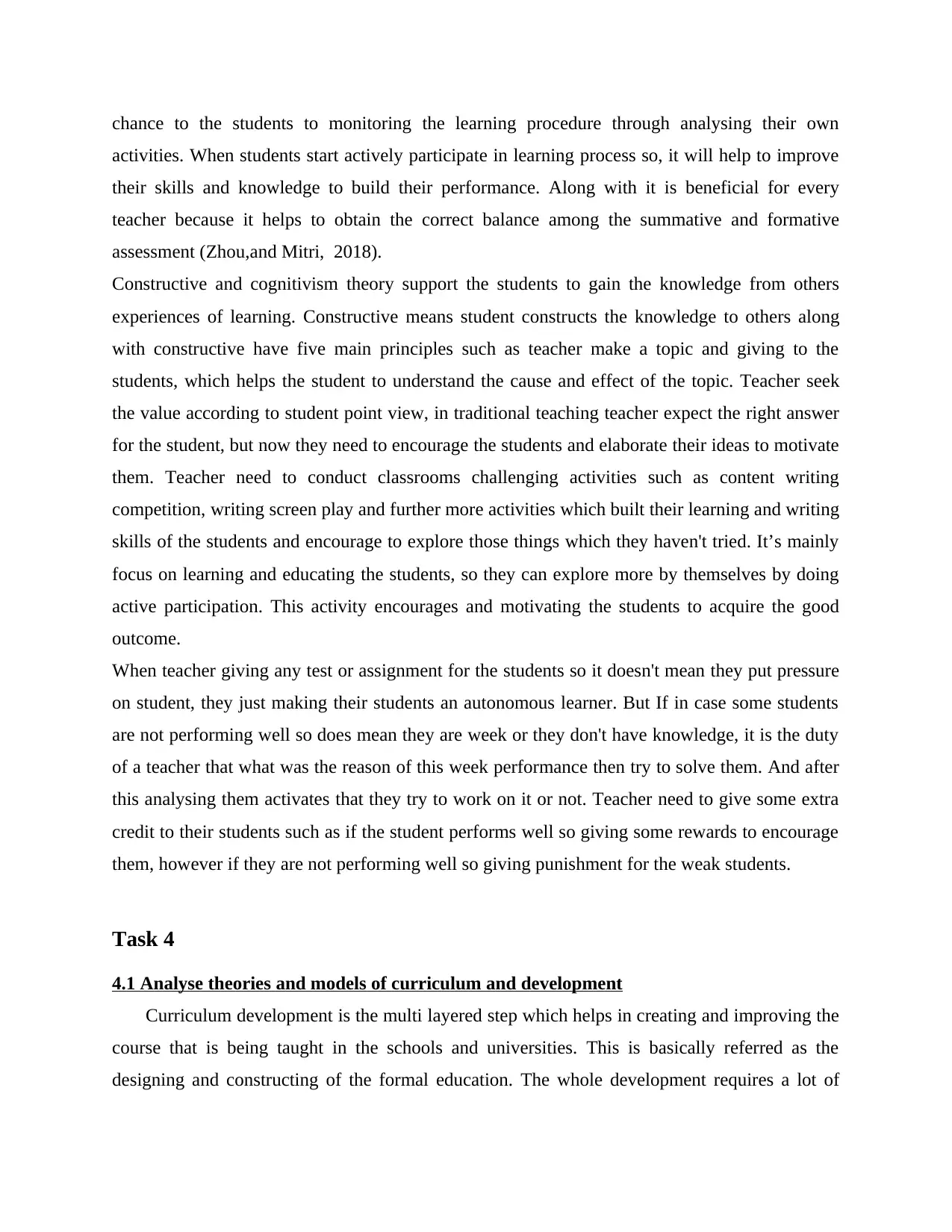
chance to the students to monitoring the learning procedure through analysing their own
activities. When students start actively participate in learning process so, it will help to improve
their skills and knowledge to build their performance. Along with it is beneficial for every
teacher because it helps to obtain the correct balance among the summative and formative
assessment (Zhou,and Mitri, 2018).
Constructive and cognitivism theory support the students to gain the knowledge from others
experiences of learning. Constructive means student constructs the knowledge to others along
with constructive have five main principles such as teacher make a topic and giving to the
students, which helps the student to understand the cause and effect of the topic. Teacher seek
the value according to student point view, in traditional teaching teacher expect the right answer
for the student, but now they need to encourage the students and elaborate their ideas to motivate
them. Teacher need to conduct classrooms challenging activities such as content writing
competition, writing screen play and further more activities which built their learning and writing
skills of the students and encourage to explore those things which they haven't tried. It’s mainly
focus on learning and educating the students, so they can explore more by themselves by doing
active participation. This activity encourages and motivating the students to acquire the good
outcome.
When teacher giving any test or assignment for the students so it doesn't mean they put pressure
on student, they just making their students an autonomous learner. But If in case some students
are not performing well so does mean they are week or they don't have knowledge, it is the duty
of a teacher that what was the reason of this week performance then try to solve them. And after
this analysing them activates that they try to work on it or not. Teacher need to give some extra
credit to their students such as if the student performs well so giving some rewards to encourage
them, however if they are not performing well so giving punishment for the weak students.
Task 4
4.1 Analyse theories and models of curriculum and development
Curriculum development is the multi layered step which helps in creating and improving the
course that is being taught in the schools and universities. This is basically referred as the
designing and constructing of the formal education. The whole development requires a lot of
activities. When students start actively participate in learning process so, it will help to improve
their skills and knowledge to build their performance. Along with it is beneficial for every
teacher because it helps to obtain the correct balance among the summative and formative
assessment (Zhou,and Mitri, 2018).
Constructive and cognitivism theory support the students to gain the knowledge from others
experiences of learning. Constructive means student constructs the knowledge to others along
with constructive have five main principles such as teacher make a topic and giving to the
students, which helps the student to understand the cause and effect of the topic. Teacher seek
the value according to student point view, in traditional teaching teacher expect the right answer
for the student, but now they need to encourage the students and elaborate their ideas to motivate
them. Teacher need to conduct classrooms challenging activities such as content writing
competition, writing screen play and further more activities which built their learning and writing
skills of the students and encourage to explore those things which they haven't tried. It’s mainly
focus on learning and educating the students, so they can explore more by themselves by doing
active participation. This activity encourages and motivating the students to acquire the good
outcome.
When teacher giving any test or assignment for the students so it doesn't mean they put pressure
on student, they just making their students an autonomous learner. But If in case some students
are not performing well so does mean they are week or they don't have knowledge, it is the duty
of a teacher that what was the reason of this week performance then try to solve them. And after
this analysing them activates that they try to work on it or not. Teacher need to give some extra
credit to their students such as if the student performs well so giving some rewards to encourage
them, however if they are not performing well so giving punishment for the weak students.
Task 4
4.1 Analyse theories and models of curriculum and development
Curriculum development is the multi layered step which helps in creating and improving the
course that is being taught in the schools and universities. This is basically referred as the
designing and constructing of the formal education. The whole development requires a lot of
⊘ This is a preview!⊘
Do you want full access?
Subscribe today to unlock all pages.

Trusted by 1+ million students worldwide
1 out of 25
Related Documents
Your All-in-One AI-Powered Toolkit for Academic Success.
+13062052269
info@desklib.com
Available 24*7 on WhatsApp / Email
![[object Object]](/_next/static/media/star-bottom.7253800d.svg)
Unlock your academic potential
Copyright © 2020–2025 A2Z Services. All Rights Reserved. Developed and managed by ZUCOL.

